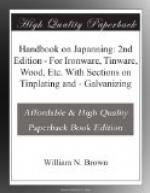The amalgam process is not so much used as it was formerly. It consists in applying to the clean and dry metallic surface a film of a pasty amalgam of tin with mercury, and then exposing the surface to heat, which volatilizes the latter, leaving the tin adhering to the metal.
The immersion process is the best adapted to coating articles of brass or copper. When immersed in a hot solution of tin properly prepared the metal is precipitated upon their surfaces. One of the best solutions for this purpose is the following:—
Ammonia alum 17-1/4 oz. Boiling 12-1/2 lb. Protochloride of tin 1 oz.
The articles to be tinned must be first thoroughly cleansed, and then kept in the hot solution until properly whitened. A better result will be obtained by using the following bath, and placing the pieces in contact with a strip of clean zinc, also immersed:—
Bitartrate of potassium 14 oz. Soft water 24 " Protochloride of tin 1 "
It should be boiled for a few minutes before using.
The following is one of the best solutions for plating with tin by the battery process:—
Potassium pyrophosphate 12 oz. Protochloride of tin 4-1/2 " Water 20 "
The anode or feeding-plate used in this bath consists of pure Banca tin. This plate is joined to the positive (copper or carbon) pole of the battery, while the work is suspended from a wire connected with the negative (zinc) pole. A moderately strong battery is required, and the work is finished by scratch-brushing.
In Weigler’s process a bath is prepared by passing washed chlorine gas into a concentrated aqueous solution of stannous chloride to saturation, and expelling excess of gas by warming the solution, which is then diluted with about ten volumes of water, and filtered, if necessary. The articles to be plated are pickled in dilute sulphuric acid, and polished with fine sand and a scratch-brush, rinsed in water, loosely wound round with zinc wire or tape, and immersed in the bath for ten or fifteen minutes at ordinary temperatures. The coating is finished with the scratch-brush and whiting. By this process cast-or wrought-iron, steel, copper, brass, and lead can be tinned without a separate battery. The only disadvantage of the process is that the bath soon becomes clogged up with zinc chloride, and the tin salt must be frequently removed. In Hern’s process a bath composed of—
Tartaric acid 2 oz. Water 100 " Soda 3 " Protochloride of tin 3 "
is employed instead of the preceding. It requires a somewhat longer exposure to properly tin articles in this than in Weigler’s bath. Either of these baths may be used with a separate battery.




